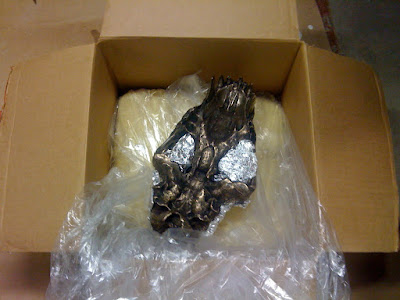By the way, the title of this post is not reflective of the opinions of my employer, in fact, I've been shafted by all of the common carriers, FedEx is just the one who's done it most recently. The VPL recently loaned a cast of a Homotherium serum skull from Freisenhahn Cave here in Texas to the Field Museum for a traveling exhibit that they've developed called Mammoths and Mastodons: Titans of the Ice Age. This cast happened to be awesomely made of bronze, so it weighed about 25 pounds with wicked scimitar teeth sticking out at crazy angles. After {common carrier} loads it's prepaid and heavily insured (but don't worry, that insurance doesn't actually cover any of the stuff you'd want it to, just set that money on fire and then flush it down the toilet) cargo into the catapult and points it roughly in the direction of the address on the label,
 you really start to hope it hits the pile of mattresses outside the "sorting facility". Since we here at VPL extra-love big chunks of fossil shaped metal, we decided to give this specimen the best chance we could of surviving the trip.
you really start to hope it hits the pile of mattresses outside the "sorting facility". Since we here at VPL extra-love big chunks of fossil shaped metal, we decided to give this specimen the best chance we could of surviving the trip. The elegant solution to this problem was boxing the specimens in expanding polyurethane foam, in this case some leftover Polytek Polyfoam. First, the bottom of the box was lined with a plastic bag, a small quantity of foam was mixed and poured into the bag, and then as the foam began to expand the bag was closed up and the skull pressed into it to create a very snug form fitting barrier.
The elegant solution to this problem was boxing the specimens in expanding polyurethane foam, in this case some leftover Polytek Polyfoam. First, the bottom of the box was lined with a plastic bag, a small quantity of foam was mixed and poured into the bag, and then as the foam began to expand the bag was closed up and the skull pressed into it to create a very snug form fitting barrier. You'll notice the aluminum foil that is scrunched up into any undercuts, so that unpacking the specimen does not require the use of a saw, fire, teeth, or any of those other old stand-bys.
You'll notice the aluminum foil that is scrunched up into any undercuts, so that unpacking the specimen does not require the use of a saw, fire, teeth, or any of those other old stand-bys.An additional small bag was poured to surround the mandibles, and then a final cap was made to fill in the top of the cardboard box. The last two pictures show the top of the foam packing in place... the box closed up, and for maximum survivability, double boxed with packing peanuts. This method of completely encapsulating the object in foam eliminates any space for the specimen to accelerate from one side of the package to another, which normally breaks things up but contains them within the original packaging. In the case of a twentyfive pound pointy alloy of copper and tin, it would tend to accelerate right through the side of the package. When you try to file a claim on that, Fe{common carrier}Ex will just tell you that it was not packed properly to sustain a fall of 132 stories, and that next time you need to provide receipts for your packing material.




No comments:
Post a Comment